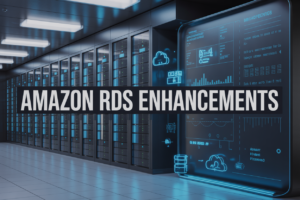Are you tired of manual code deployments that eat up your time and introduce errors? 🤔 Imagine a world where your code flows seamlessly from development to production, with quality checks at every step. Welcome to the game-changing realm of AWS CI/CD services!
In today’s fast-paced tech landscape, delivering high-quality software quickly is no longer a luxury—it’s a necessity. But how can you ensure rapid, reliable deployments without sacrificing quality? The answer lies in automating your build, test, and deployment processes using AWS’s powerful suite of CI/CD tools. 💪
Join us as we dive deep into the world of AWS CI/CD services, exploring everything from setting up your environment to orchestrating complex pipelines. We’ll guide you through each step of implementing a robust CI/CD process, sharing best practices and insider tips along the way. Whether you’re a seasoned DevOps pro or just starting your automation journey, this guide will equip you with the knowledge to revolutionize your software delivery pipeline. Let’s embark on this exciting journey to streamline your development workflow and boost your team’s productivity!
Understanding AWS CI/CD Services
Overview of AWS CodePipeline
AWS CodePipeline is a fully managed continuous delivery service that helps you automate your release pipelines for fast and reliable application and infrastructure updates. Here are key features and benefits:
- Automated workflow: Orchestrates the entire software release process
- Visual interface: Provides an easy-to-use GUI for pipeline management
- Customizable stages: Allows for flexible pipeline configuration
- Integration with AWS services: Seamlessly works with other AWS tools
| Feature | Benefit |
|---|---|
| Automated releases | Reduces manual errors and speeds up delivery |
| Pipeline as code | Enables version control of pipeline configurations |
| Parallel actions | Improves efficiency by running tasks simultaneously |
| Event-driven execution | Triggers pipelines based on code changes or schedules |
Key features of AWS CodeBuild
AWS CodeBuild is a fully managed build service that compiles source code, runs tests, and produces software packages. Notable features include:
- Preconfigured build environments
- Customizable build specifications
- Scalable build infrastructure
- Integration with source control systems
Benefits of AWS CodeDeploy
AWS CodeDeploy automates code deployments to any instance, including Amazon EC2 instances and on-premises servers. Key advantages are:
- Consistent deployments across environments
- Rollback and version control capabilities
- Minimized downtime during deployments
- Support for various deployment strategies (e.g., blue/green, canary)
Integration with other AWS services
AWS CI/CD services seamlessly integrate with numerous AWS offerings, enhancing the overall development pipeline:
- AWS Lambda for serverless computing
- Amazon S3 for artifact storage
- AWS CloudFormation for infrastructure as code
- Amazon CloudWatch for monitoring and logging
This integration enables a comprehensive DevOps workflow, from code commit to production deployment, all within the AWS ecosystem.
Setting Up Your AWS CI/CD Environment
Creating an AWS account and configuring IAM roles
To begin your AWS CI/CD journey, you’ll need to set up an AWS account and configure the necessary IAM roles. This process involves creating your account, setting up Multi-Factor Authentication (MFA) for enhanced security, and defining roles with appropriate permissions.
-
Create an AWS account:
- Visit the AWS website
- Click on “Create an AWS Account”
- Follow the prompts to provide necessary information
-
Enable MFA:
- Navigate to the IAM dashboard
- Select your root user
- Add MFA device (virtual or hardware token)
-
Configure IAM roles:
| Role Name | Purpose | Key Permissions |
|---|---|---|
| CodeBuildRole | For AWS CodeBuild | CodeBuild, S3, ECR |
| CodeDeployRole | For AWS CodeDeploy | CodeDeploy, EC2, S3 |
| CodePipelineRole | For AWS CodePipeline | CodePipeline, S3, CodeBuild, CodeDeploy |
Installing necessary AWS CLI tools
After setting up your account and roles, you’ll need to install the AWS Command Line Interface (CLI) tools. These tools allow you to interact with AWS services from your local machine, facilitating the CI/CD process.
-
Install AWS CLI:
- Download from the official AWS website
- Follow installation instructions for your operating system
- Verify installation:
aws --version
-
Configure AWS CLI:
- Run
aws configure - Enter your AWS Access Key ID and Secret Access Key
- Specify your default region and output format
- Run
Preparing your source code repository
With your AWS environment set up, it’s time to prepare your source code repository. This step is crucial for integrating your development workflow with AWS CI/CD services.
Building Your Code Automatically
Configuring AWS CodeBuild projects
AWS CodeBuild simplifies the process of automatically building your code. To set up a CodeBuild project:
- Navigate to the AWS CodeBuild console
- Click “Create build project”
- Configure project settings:
- Name your project
- Choose source provider (e.g., GitHub, AWS CodeCommit)
- Select environment image
- Define build specifications location
Defining build specifications
Build specifications are crucial for CodeBuild to understand how to build your project. Create a buildspec.yml file in your repository root:
version: 0.2
phases:
install:
runtime-versions:
nodejs: 14
pre_build:
commands:
- npm install
build:
commands:
- npm run build
artifacts:
files:
- '**/*'
name: my-app-$(date +%Y-%m-%d)
Handling dependencies and artifacts
CodeBuild manages dependencies and artifacts efficiently:
| Feature | Description |
|---|---|
| Cache | Store dependencies to speed up builds |
| Artifacts | Output files generated during the build |
To optimize artifact handling:
- Use selective artifact packaging
- Implement caching for frequently used dependencies
Optimizing build performance
Improve your build speed and efficiency:
- Use managed environments when possible
- Parallelize build steps where appropriate
- Implement caching strategies
- Right-size your build environment
By following these steps, you’ll create an efficient automated build process using AWS CodeBuild. Next, we’ll explore how to implement automated testing to ensure the quality of your builds.
Implementing Automated Testing
Integrating unit tests into the build process
Unit testing is a crucial part of any CI/CD pipeline. With AWS CodeBuild, you can seamlessly integrate unit tests into your build process. Here’s how to set it up:
- Add test dependencies to your
buildspec.ymlfile - Include test execution commands in the build phase
- Configure CodeBuild to report test results
Here’s an example of a buildspec.yml configuration for running unit tests:
version: 0.2
phases:
install:
runtime-versions:
nodejs: 14
pre_build:
commands:
- npm install
build:
commands:
- npm run test
post_build:
commands:
- echo Build completed on `date`
reports:
junit:
files:
- 'test-results.xml'
file-format: JUNITXML
Configuring integration tests
Integration tests ensure different components of your application work together correctly. To set up integration tests:
- Create a separate test environment in AWS
- Configure AWS CodePipeline to deploy to this environment
- Run integration tests using tools like Selenium or Postman
| Test Type | Tool | AWS Integration |
|---|---|---|
| UI Tests | Selenium | AWS Device Farm |
| API Tests | Postman | AWS API Gateway |
Setting up performance and security testing
Performance and security testing are vital for robust applications. Here’s how to implement them:
- Use AWS CloudWatch for performance monitoring
- Implement load testing with Apache JMeter or Gatling
- Integrate security scanning tools like OWASP ZAP
Managing test reports and notifications
Effective reporting is key to a successful CI/CD pipeline. AWS provides several options:
- Use AWS CloudWatch Logs for centralized log management
- Configure SNS notifications for test failures
- Integrate with third-party tools like Slack for real-time alerts
By implementing these automated testing strategies, you’ll significantly improve your code quality and deployment reliability. Next, we’ll explore how to streamline the deployment process using AWS CodeDeploy.
Streamlining Deployment with AWS CodeDeploy
Creating deployment groups and configurations
AWS CodeDeploy streamlines the deployment process by allowing you to create deployment groups and configurations. Deployment groups define the set of instances or Lambda functions where your application will be deployed, while configurations specify how the deployment should be executed.
To create a deployment group:
- Open the AWS CodeDeploy console
- Select your application
- Click “Create deployment group”
- Choose a name and service role
- Select your compute platform (EC2/On-premises or Lambda)
- Define your deployment settings
Deployment configurations determine how your application is deployed across your infrastructure. Here’s a comparison of common deployment configurations:
| Configuration | Description | Best for |
|---|---|---|
| AllAtOnce | Deploys to all instances simultaneously | Small applications, testing |
| OneAtATime | Deploys to one instance at a time | Production environments, minimal downtime |
| HalfAtATime | Deploys to 50% of instances at a time | Balance between speed and safety |
Implementing blue-green deployments
Blue-green deployments are a powerful technique for minimizing downtime and risk during updates. This method involves creating two identical production environments:
- Blue environment: Current production version
- Green environment: New version being deployed
Steps for implementing blue-green deployments:
- Create a new “green” environment
- Deploy the new version to the green environment
- Test the green environment
- Switch traffic from blue to green
- Monitor for issues
- If successful, decommission the blue environment
Blue-green deployments offer several advantages:
- Reduced downtime
- Easy rollback
- Opportunity for final testing in production-like environment
Handling rollbacks and deployment failures
Orchestrating the CI/CD Pipeline
Designing your pipeline structure
When orchestrating your CI/CD pipeline in AWS, the first step is to design an efficient pipeline structure. A well-designed pipeline ensures smooth code progression from development to production. Consider the following elements:
- Source control
- Build process
- Testing stages
- Deployment environments
Here’s a sample pipeline structure:
| Stage | Purpose | AWS Service |
|---|---|---|
| Source | Code repository | AWS CodeCommit |
| Build | Compile and package code | AWS CodeBuild |
| Test | Run automated tests | AWS CodeBuild |
| Deploy to Staging | Deploy to staging environment | AWS CodeDeploy |
| Manual Approval | Quality assurance check | AWS CodePipeline |
| Deploy to Production | Deploy to production environment | AWS CodeDeploy |
Configuring pipeline stages and actions
Once you’ve designed your pipeline structure, it’s time to configure the stages and actions in AWS CodePipeline. Each stage represents a phase in your software release process, while actions define the specific tasks within each stage.
Key configuration steps:
- Set up source providers (e.g., CodeCommit, GitHub)
- Define build specifications in buildspec.yml
- Configure test environments and scripts
- Specify deployment groups and strategies
Implementing approval gates and manual interventions
To ensure quality and control in your pipeline, implement approval gates and manual interventions. These allow for human oversight at critical points in the process.
- Use manual approval actions in CodePipeline
- Set up SNS notifications for approvers
- Define IAM roles for approval permissions
Integrating with external tools and services
Enhance your pipeline by integrating with external tools and services. This can extend functionality and improve overall efficiency.
Integration options:
- Third-party testing tools
- Notification services (e.g., Slack, Microsoft Teams)
- Security scanning tools
- Performance monitoring services
By carefully orchestrating your CI/CD pipeline, you create a robust, efficient, and flexible system for delivering high-quality software. Next, we’ll explore how to monitor and optimize your CI/CD process to ensure it continues to meet your evolving needs.
Monitoring and Optimizing Your CI/CD Process
Setting up CloudWatch alarms and metrics
To effectively monitor your CI/CD process, setting up CloudWatch alarms and metrics is crucial. Here’s a step-by-step guide:
-
Define key metrics:
- Pipeline execution time
- Build success rate
- Deployment frequency
- Error rates
-
Create CloudWatch alarms:
- Set thresholds for each metric
- Configure notification actions (e.g., SNS topics)
-
Implement custom metrics:
- Use CloudWatch PutMetricData API
- Track application-specific performance indicators
| Metric | Threshold | Action |
|---|---|---|
| Pipeline execution time | > 30 minutes | SNS notification |
| Build success rate | < 95% | Slack alert |
| Deployment frequency | < 1 per day | Email notification |
| Error rate | > 5% | PagerDuty alert |
Analyzing pipeline performance and bottlenecks
Once you’ve set up monitoring, it’s time to analyze your pipeline’s performance:
- Use CloudWatch Logs Insights to query and visualize log data
- Identify common failure points and long-running stages
- Leverage AWS X-Ray for distributed tracing of your applications
Implementing continuous improvement strategies
With insights from your analysis, implement these strategies:
- Regularly review and update your CI/CD workflows
- Automate repetitive tasks and manual interventions
- Implement canary deployments for safer releases
- Conduct post-mortem reviews after significant incidents
Scaling your CI/CD infrastructure
As your project grows, scale your CI/CD infrastructure to maintain performance:
- Use AWS Auto Scaling for build and deployment resources
- Implement caching strategies to speed up builds
- Leverage spot instances for cost-effective scaling of build environments
- Consider multi-region deployments for global applications
By continuously monitoring, analyzing, and optimizing your CI/CD process, you’ll ensure a robust and efficient pipeline that scales with your project’s needs.
Best Practices for AWS CI/CD Implementation
Securing your CI/CD pipeline
When implementing AWS CI/CD, security should be a top priority. Here are key practices to secure your pipeline:
- Use IAM roles and least privilege principle
- Implement secrets management
- Enable AWS CloudTrail for auditing
- Encrypt data at rest and in transit
| Security Measure | Description |
|---|---|
| IAM roles | Assign specific permissions to services and users |
| Secrets management | Use AWS Secrets Manager to store sensitive information |
| CloudTrail | Monitor and log API calls for accountability |
| Encryption | Protect data using AWS KMS for encryption keys |
Managing environment variables and secrets
Proper management of environment variables and secrets is crucial for maintaining security and flexibility in your CI/CD pipeline:
- Use AWS Systems Manager Parameter Store for non-sensitive configuration
- Leverage AWS Secrets Manager for sensitive information
- Rotate secrets regularly using automated processes
- Implement strict access controls for secrets management
Implementing infrastructure as code
Infrastructure as Code (IaC) is essential for maintaining consistency and reproducibility:
- Use AWS CloudFormation or AWS CDK for infrastructure definition
- Version control your IaC templates
- Implement automated testing for infrastructure code
- Utilize drift detection to ensure consistency
Adopting GitOps principles
GitOps enhances collaboration and maintains a single source of truth:
- Store all configurations in Git repositories
- Implement pull-based deployment models
- Use automated reconciliation tools
- Enforce code review processes for all changes
By following these best practices, you’ll create a robust, secure, and efficient CI/CD pipeline on AWS. Next, we’ll explore advanced techniques for optimizing your CI/CD process and maximizing its effectiveness in your development workflow.
Embracing AWS CI/CD services for automated code build, test, and deployment can significantly enhance your software development lifecycle. By leveraging tools like AWS CodeBuild, CodePipeline, and CodeDeploy, you can create a seamless, efficient, and reliable pipeline that accelerates your development process and improves code quality.
Implementing best practices, such as continuous monitoring and optimization, ensures your CI/CD pipeline remains effective and adapts to your evolving needs. As you embark on your AWS CI/CD journey, remember that the key to success lies in careful planning, robust testing, and a commitment to continuous improvement. Start small, iterate often, and watch as your development team’s productivity and software quality soar to new heights.



















